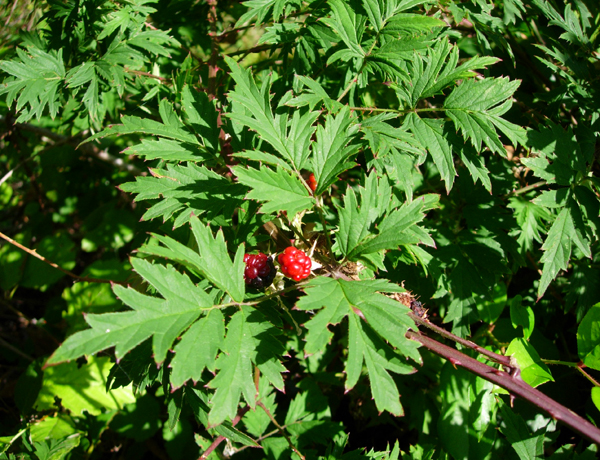Cutleaf blackberry identification and control
Information about the noxious weed, cutleaf blackberry. Cutleaf blackberry is also known as evergreen blackberry. Its Latin name is Rubus laciniatus.
About this weed
Cutleaf blackberry is a non-regulated Class C noxious weed. This means due to how widespread it is, property owners are not required to control this species on their property, though it is always encouraged.
Cutleaf blackberry is known as Rubus laciniatus. It is a member of the rose family. It is also known as evergreen blackberry.

Why it’s a problem
Cutleaf blackberry has escaped cultivation and become very widespread in the landscape. Cutleaf blackberry is spread by birds, animals, and disturbance. In King County, cutleaf blackberry can be found in sunny, disturbed ecosystems at low elevations.
Cutleaf blackberry outcompetes native ground layer vegetation. Thickets become very dense, and animals have a hard time moving through the landscape. Cutleaf blackberry can also mask eroding conditions on hillsides and riverbanks.
Plant description
Cutleaf blackberry’s native range is Europe. Cutleaf blackberry occurs primarily on the Western side of the Cascades in Washington. It can be found from British Columbia to California, as well as east in Idaho, Montana, and Wyoming.
Cutleaf blackberry has small, white to pinkish flowers with 5 petals that have 3 lobes at the tips. Flowers are clustered in groups of 5 to 20.
It has ridged, arching canes with stiff, curved prickles. It can grow up to 13 feet tall and canes can be over 30 feet in length.
Leaves are palmately compound with deeply incised, toothed leaflets usually in groups of 5 on the main stem.
It produces large blackberries that are edible and very tasty.
Root crowns on established plants are large, starchy, and unusually shaped with sprawling, deep roots. Cutleaf blackberry closely resembles Himalayan blackberry, except for the cut-leaf shape.
Cutleaf blackberry is much more robust and imposing as compared to our native trailing blackberry, Rubus ursinus.




Be aware of look-alike plants
Cutleaf blackberry is often confused with:
Himalayan blackberry has rounded to oblong leaves with toothed edges while evergreen blackberry has ragged looking leaves that are deeply lacerated or incised.
Vested blackberry resembles Himalayan blackberry, but has a hairy, rounded main stem with straight, slender prickles. Cutleaf blackberry has mostly smooth, ridged main stems with curved prickles.
When in doubt, take photos and report them on iNaturalist.
What to do if you find it
Because cutleaf blackberry is so widespread, property owners in King County are not required to control it. King County is not generally tracking infestations. We can provide advice on how to control cutleaf blackberry, but there is generally no legal requirement to do so.
The King County Noxious Weed Control Board encourages property owners to remove cutleaf blackberry where possible, and to avoid introducing it to new landscapes.
Control methods
We recommend using a combination of methods to control weeds. In areas with few weeds, it is important to act quickly before they become harder to control. Make a long-term plan as it often takes several years to get rid of most weeds. Start in the least infested areas first and then move into more heavily infested areas.
For more in-depth control information, read Best Management Practices (BMP) for evergreen blackberry
Blackberry can be controlled by digging, mowing, herbicide, plowing, or livestock grazing (especially goats).
Manual control
Removal of top growth by mowing, cutting, or grazing with goats will kill blackberry if done often (spring and fall) over several years.
Cutting followed by digging up root crowns is a very effective control method.
Chemical control
Stay safe when using herbicide:
- Always read the label before use.
- Wear a long-sleeved shirt, long pants, shoes, and eye protection.
- Follow state and local regulations.
For patches that are too large to dig up or mow, the most effective method is to apply herbicide. Apply herbicide to the foliage or live wood area of the canes of actively growing plants. Use the foliar or cut stump methods with an herbicide such as triclopyr, imazapyr, or glyphosate. Application of herbicides in late summer to fall (when native plants are dormant) will reduce off-target damage and improve control versus application in the spring.
See the PNW Pest Management Handbook for the most up to date and specific method for chemical control of cutleaf blackberry.
Avoid spraying where there is a chance that herbicide will enter a waterway or wetland unless you are using a state-approved aquatic herbicide and have the required permits and licenses to do so. Use of pesticides in water is regulated in Washington state. See Washington Department of Ecology Aquatic Pesticide Permits for details.
For more information or a site-specific control recommendation in King County, contact the noxious weed program. For information in other counties in Washington state, contact your local weed board or your local cooperative extension office.
Disposal instructions
Cutleaf blackberry roots and shoot tips may continue to grow if they contact the ground. Pile blackberry canes and roots on tarps, downed logs, brush piles, or other elevated surfaces so stems will dry out.
If creating piles on-site is not an option, dispose of blackberry roots in yard waste bins or take to a transfer station. Home compost systems may not create high enough temperatures required to kill the seeds within the berries.
Noxious Weed Disposal - Washington State Noxious Weed Control Board

 Translate
Translate